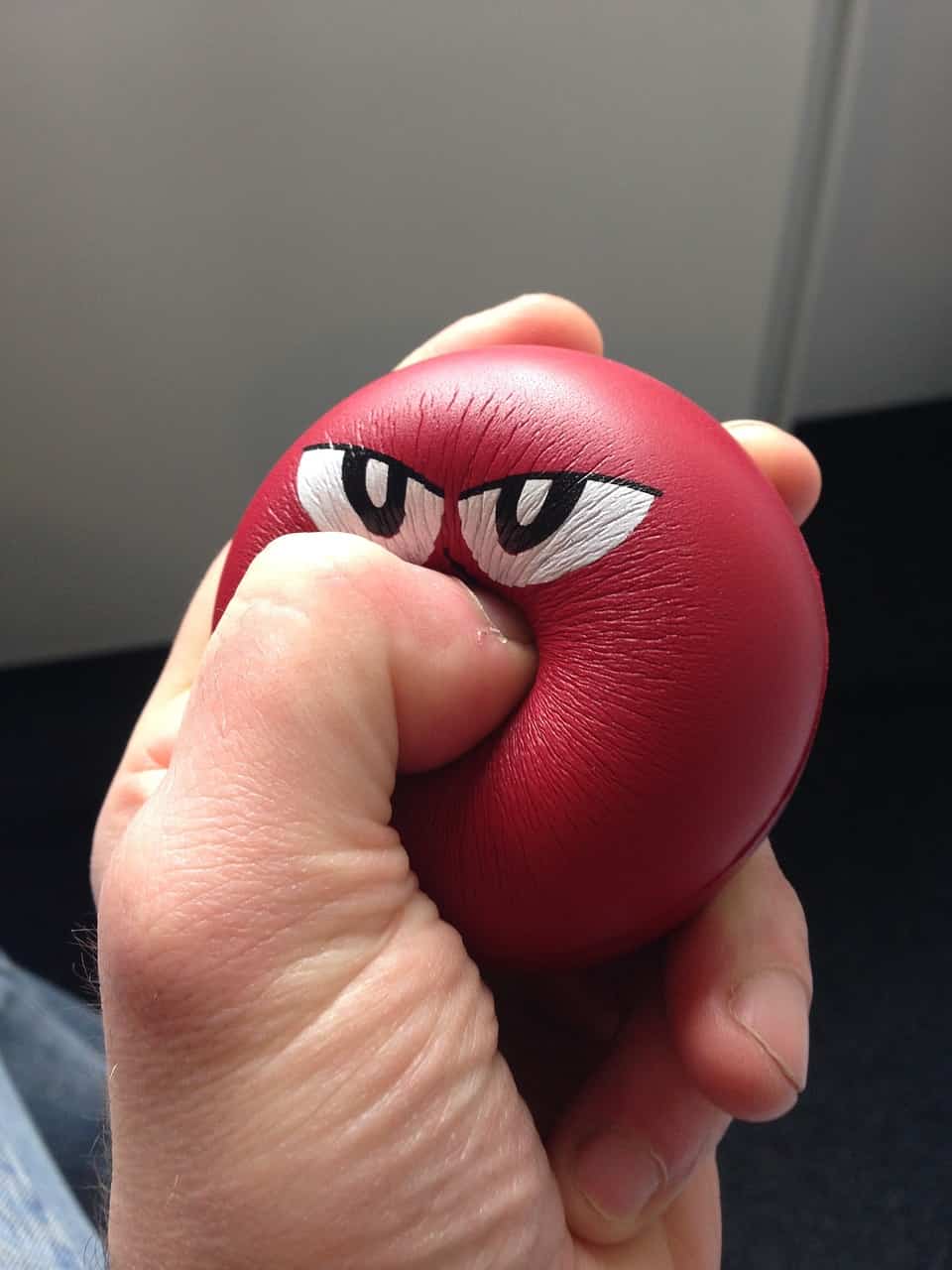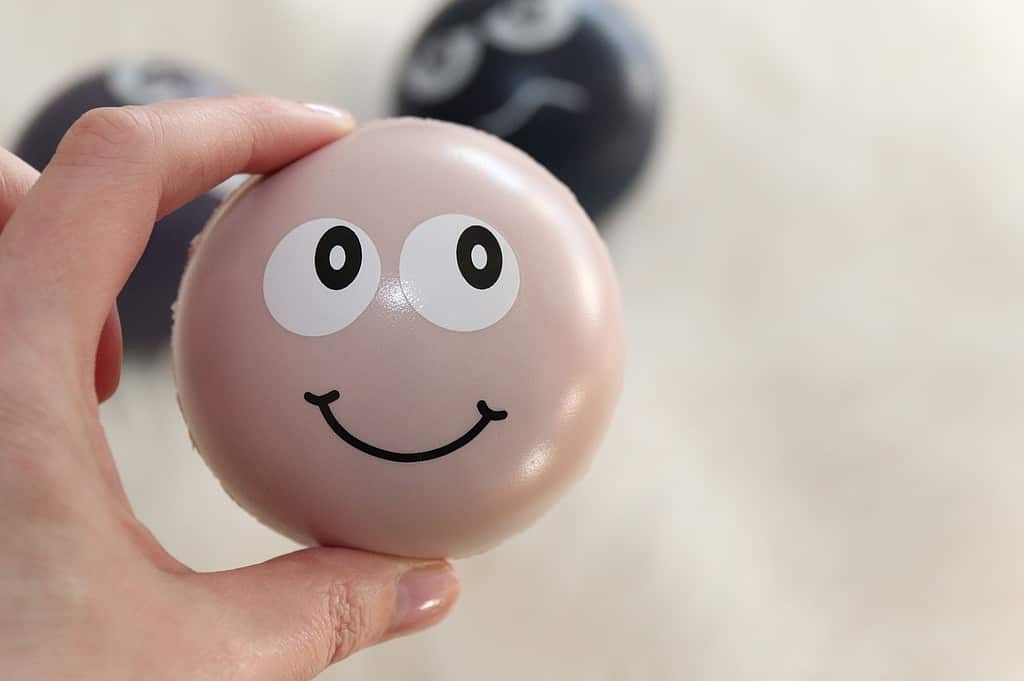In their quest to relieve stress, many people turn to various tools and techniques. One such popular tool is the stress ball—a small, squeezable toy that promises to alleviate tension and promote relaxation.
You’ve probably seen some of those semi-soft foam balls adorning virtually every corporate office, enticing people to release tension by squeezing them between their fingers. But do these ridiculous balls actually help people decompress? Should you regularly use them or is it a better idea to blow off some steam by throwing stress balls out the window?
From work to school to romantic relationships, there’s no shortage of challenges in our lives. Often, this creates an internal conflict that manifests itself as stress. When left unchecked, stress will not only take its toll on our emotional and mental health but also on our physical well-being.
Enter stress balls — a low-key and effective solution to managing temporary stress.
How Do Stress Balls Work?
It may sound implausible, but the answer to the question, “Do stress balls work?” is yes – at least from a physiological standpoint.
Have you ever noticed how a comforting touch can instantly soothe your frayed nerves? Researchers believe that the power of tactile engagement lies at the heart of stress balls’ effectiveness. When you squeeze a stress ball, the muscles in your hand and forearm contract, triggering a series of physiological responses in your body. As you release the grip, these muscles relax, promoting a sense of relief and relaxation.

In 2006, researchers found that stress balls can improve the focus and attention spans of sixth graders. Another study found that fidgeting with objects — squeezing a stress ball or twirling a pen, for instance — can help boost productivity by giving the mind a break, making it easier to pay attention to the task upon returning to it.
According to MIT researchers, fidgeting objects designed to soothe or calm have to be smooth or squeezable, whereas fidgets meant to make people alert are generally clickable, sharp, or pokey. Yet another study found that stress balls helped relieve patients’ anxiety during surgery.
However, the only study that specifically researched the effectiveness of stress balls in reducing the physiological symptoms of stress found that they don’t do much. The researchers at the University of Wisconsin-Madison found that stress balls are not effective in reducing heart rate, blood pressure, or skin conductance following an episode of induced acute stress in college-aged individuals. The sample size was rather small, though, and involved only 30 students.
Do stress balls also work for anxiety? Studies suggest they do. Stress balls work to reduce stress because the act of squeezing improves the nervous system as well as decreases hormones, which can minimize stress levels.
Stress balls can squeeze out stress, but they’re no cure for chronic stress
In light of its productivity-enhancing and anxiety-relieving properties, stress balls may be worth your time.
Bear in mind that if you’re chronically stressed, no amount of squishy foam balls or teddy bears will help you in the long run. To release the physical and emotional tension in the body from ongoing stress, doctors recommend exercising, dancing, venting with friends, and — why not — letting it all out by crying or shouting.
While stress balls offer a range of benefits, it is essential to acknowledge their limitations. While they may provide immediate relief, their effects are often temporary and may not address the underlying causes of stress.
Additionally, stress balls may not be suitable for everyone. Individuals with certain hand conditions, such as arthritis or carpal tunnel syndrome, should consult with their healthcare provider before incorporating stress balls into their routine.
What Are The Benefits of Using Stress Balls?

America’s favorite squeezable knick-knack has come a long way since it was invented in the 1980s by Alex Carswell, a 29-year-old TV writer who came up with the idea after an angry phone call with his boss compelled him to throw a magic marker at a framed photo of his mother.
“It made me feel very good at the moment,” Carswell said later that year, “but I also had a broken picture of my mother and her dog I had to get reframed, and a mess to clean up.”
Today, hundreds of millions of foam balls are being manufactured all over the world. But do they actually do anything?
It might be tempting to laugh off the potential benefits of these handheld wonders, but in truth, we stand to gain a lot from them. Stress balls have the capacity to enhance creativity, improve focus, reduce blood pressure, and even help you get a better night’s sleep.
And while they’re not exactly meant for bodybuilding, a stress ball can certainly strengthen your grip muscles as well as help alleviate arthritis pain. So, if you’re wondering how stress balls work – they work on various different levels. Ultimately, a stress ball can be used as a distraction device, or a different focal point, essentially allowing you to manage stress levels in a healthy way.
Speaking to the Huffington Post, David Posen, a stress expert and author of “Is Work Killing You?: A Doctor’s Prescription for Treating Workplace Stress,” says that at least some of that stress energy can be channeled towards a physical object. Stress balls can work really well, Posen says, because they prompt you to squeeze and release, leaving you less tense.
What Are The Different Types of Stress Balls?

You might be surprised to learn there are over a dozen different types of stress balls. In fact, there is a ball for pretty much every type of personality wanting to squeeze their way into a stress-free lifestyle.
In the US, the most popular choice is a bean bag type of stress reliever, but there are a variety of types all around the world. Construction of these anxiety-reducing balls can range from gel-filled, water-filled, solid foam, rubber, or a filling mixed with gel and baking soda.
Since their inception, stress balls have evolved into all sorts of varieties such as porcupine balls, squeezy balls, kooshy balls, splat balls, puffer balls, and the list goes on.
The common denominator for all of these different types of stress balls is that, on some level, they are intended to release tension, therefore, reduce stress.
How Long Do Stress Balls Last?
The answer to this question depends upon the type of ball you have and how much you’re using it. In general, most stress balls last a few months. If you have a high-quality ball made with durable materials, it could last up to a year or more. Cheaper balls made with flimsy materials will begin to deteriorate quickly.
Of course, if your dog gets hold of your stress ball, it’s not going to last very long at all. In all seriousness, your ball should last a good, long time if it is made of sturdy materials, well-cared for, and used in moderation.
Are Stress Balls Good For Your Hands?
Stress balls can be good for your hands because they build strength. They can also be beneficial for building strength in your forearms and wrists. Using stress balls can increase flexibility and stimulate blood circulation, which leads to decreased stiffness and swelling.
When used in moderation, yes, stress balls can be therapeutic for your hands, fingers, wrists, and forearms. While stress balls are used for certain types of physical therapy, they are not always the best for your hands. Overuse of stress balls can cause strains in tendons in the wrists or might cause pain.
What Are the Symptoms of Stress?
The curious thing about stress is that it manifests differently in each person. For instance, some people may exhibit stress by sweating profusely or hyperventilating. Other people might show symptoms of stress emotionally by becoming irascible or aggressive, while others might express stress by withdrawing, becoming sullen, or succumbing to depression.
Moreover, stress can manifest itself in ways we normally wouldn’t, such as acting out, exhibiting nervous ticks such as nail-biting or using substances. While these are manifestations of stress, they are also behaviors that are symptoms of stress as many of us attempt to compensate or escape the unfavorable experience of stress. All in all, there are innumerable ways symptoms of stress might manifest in different people under various conditions.
Chronic stress can lead to headaches, an upset stomach, sleep problems, and fatigue. If left unchecked, stress can contribute to far more serious health problems, such as high blood pressure, diabetes, and obesity.
One of the symptoms of stress is muscle tension. We literally clench our body’s muscles when feeling psychologically stressed, prompted by a flood of hormones like adrenaline, noradrenaline, and cortisol. Essentially, these chemicals prime the body for “fight or flight”.
However, it’s not always an option to fight your boss or run away from work — this is where the ubiquitous stress ball might come in handy.
Can Stress Be Measured?
Yes, stress can be measured. Observation of heart rate, pulse, breathing, and emotional responses and recording this data is the most common way to measure stress. But how can stress be measured?
In many instances, we can measure our own stress levels by paying attention to our responses and reactions to stressful situations. Through self-observation and recording our responses, we are better able to understand our stress levels and adjust accordingly.
Are there objective tests for stress? Yes. You can do a stress level test which can provide you with valuable information about your condition and guide you to solutions to reduce stress. You may also opt to get a medical stress test from your doctor or mental health care provider. The types of stress tests you choose will depend upon your desired outcome.
For instance, if your stress manifests on a physical level, you might consider getting a cardiac stress test to assess how stress is affecting your heart. If you respond to stress more emotionally, then a mental health stress test administered by a mental professional will reveal insights that can help you manage your emotions more effectively while encountering stress.
Final words: a good tool in your stress management toolbox
While stress balls may not hold the key to complete stress eradication, their simple yet effective design offers a tangible means of managing stress and promoting relaxation.
The act of squeezing a stress ball engages both the body and the mind, providing a momentary respite from the pressures of everyday life.
Scientific research supports their effectiveness, revealing their potential to reduce stress, enhance cognitive performance, alleviate anxiety, and aid in physical rehabilitation.








